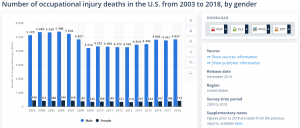On February 9th, 2019, 54-year-old Michigan steel manufacturing employee Daniel Hill experienced a particularly agonizing accident on the job. While measuring the solution of a vat of sulfuric acid, he fell in. Fully submerged, Hill suffered severe acid burns, as did his coworkers who struggled to pull him from the vat. The fire department was called, and Hill was rushed to the hospital, where he died later that night. One fire official declared he suffered some of the worst pain imaginable.

This horrific occurrence may have been a one-of-its-kind, isolated incident in the case of Daniel and his environment, but the harrowing reality is that dangerous workplace accidents claim the health and lives of men like Daniel Hill every day. It’s men who are by far most affected by this disturbing phenomenon. In the instance of virtually every physically demanding, exerting and exhausting profession—from maintenance to machinery, from construction to trucking, from roofing to rigging to mining to logging—it is men who carry the lion’s share. These occupations do not simply require manual labor and measurable body strength. They heavily and regularly tax the body and system, and oftentimes result in accidents. Accidents many and varied.
Like the case of Kyle Hancock from Glen Burnie, Maryland, who was at work on a sewer line in Baltimore on June 5th, 2018. A 15-foot trench caved on him, burying him alive. After rescue workers extracted his body from the collapsed trench, his cause of death was determined as asphyxia. He was only 20 years old.

With men in such a majority of these jobs, it’s not surprising but logical that the most workplace deaths take the lives of men. But what one may not anticipate is the startlingly high percentage. According to Forbes, 2017 saw a total of 5,147 job fatalities. 4,761 of them were male. This comes out to an equivalent of 92.5 out of 100, rounding up to 93%—an approximate representation of the entire 21st century.
It’s understandable that as we’ve seen, men both younger and older will be vastly represented in these job environments, as they are better suited to these professions and their demands. Women are capable of manual labor, bodybuilding and mass muscle development, assisted by factors like genetics and hormone treatments. But for the majority of women, these pursuits are not prioritized as worthwhile. Women tend to feel that careers in office settings, childcare and domestic maintenance are more suited to their feminine nature. Secondarily, many of them find the male-dominated milieu of manual labor undesirable. Few or none deny that of the 7% of female workplace deaths, these lost lives are as valuable as their male counterparts.
Or are they seen as more so?
Does society see fit to maintain the abundance of men in these positions because they view men as expendable? Are men utterly disposable to us? And if so, is this why the percentage of male workplace deaths is rarely seen by scratching the surface? Does the fact that these dangerous jobs pay so much more than safe employment make us indignant or unhappy, on the behalf of those who work safe, less-paying jobs? Is it all the fault of patriarchy, the universal scapegoat of gender issues?
Nicole Russell wrote astutely about the semi-visible apathy of society vis-à-vis male job mortality, stating that of the #1 most dangerous profession—logging—all the way to #20—mining—men make up anywhere from 85 to 99% of the laborers—and thus deaths. She goes on to briefly explore the motivation of men to fill these occupations—with a little help from Jordan Peterson—as well as the motivation of feminism not to care that overall, men are at risk while women work in more secure, protected environments. Is it accurate to regard women as human and men as lesser forms of life when we let men perform these labors for us at their potential peril, sometimes dying, leaving us with a gender workplace gap the size of the Grand Canyon?
Statista covered 15 years of this gender gap, with male deaths ranging from 4,216 to 5,396—a difference of over a thousand in three years. Female deaths, meanwhile, ranged from 319 to 446[5]. But if we are losing men on the job at such a clip compared to their female counterparts, and if the all-revered force of justice and human rights we call feminism is so interested in gender equality as they claim, why do its activists not seem to speak up on this subject? If they agree, and are concerned with the health and lives of men at large, where are the feminists pushing for stronger security? Stricter supervision? More preventative labor precautions? Why is the statistic of 93% male workplace deaths obscured from mainstream view?

It bears mentioning that through all of this, however, in relation, we do continue hearing fantastical tales bandied about of the feministic holy grail. The myth that refuses to die: the wage gap. Indeed, while content to pursue their less lucrative gender studies degrees, while ostensibly satisfied with fewer total hours worked, less participation in STEM, less desire or need felt to ask for higher salaries, and certainly less inclination to work in perilous professions or those seen as dirty and disdainful—ditch-digging, refuse collection, landscaping—feminists see fit nonetheless to berate the system and patriarchy, for not financially overcompensating the female population.
It has been argued by feminists that the presence of more women in dangerous careers would result in said careers being made safer. This argument is based in the supposition or stereotype that women, overall, are more sensible about safety. And while there may be something to this, the fact remains that feminists are simply not pushing for women to enter such perilous fields—which shows itself as merely another feminist strategy to maintain the gynocentric status quo.
But will more women enter the precarious, higher-waged corner of the career world, into the 2020s and future beyond? In all likelihood, doubtful. Not because women are unfit for the jobs, or because they are too cowardly, but because their innate biology and femininity discourages it. Masculinity lies of course in men’s innate nature, remaining a worthy motive for them to continue assuming hard manual labor. They’re dirty jobs, but someone has to do them. And while it should go without saying that no one wants more women to die on the job, if we view men as human beings of equal value, should we not wish to safeguard their lives as well? Should we not be concerned with saving and preserving all the lives we possibly can, regardless to whom they belong? Perhaps it all boils down to this—
Do we as a society see men as equally valuable laborers?

Additional consulted sources:
This article has been modified since being published. An early draft, rather than the final draft, was published due to a clerical error -Ed